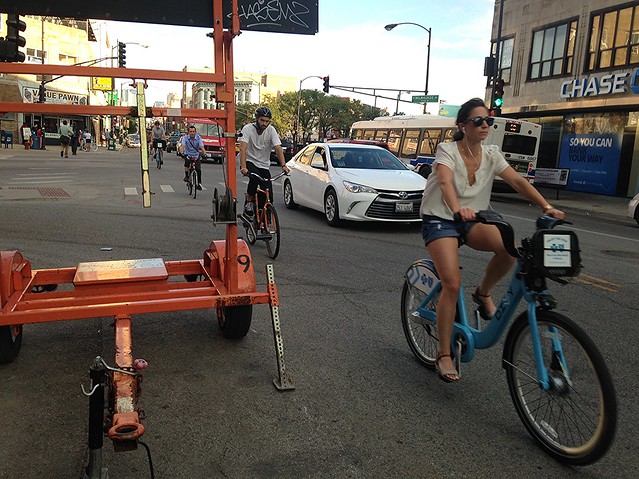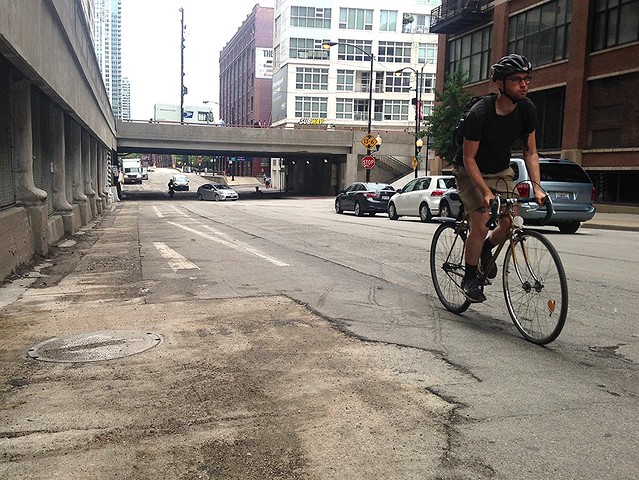
[Last year the Chicago Reader launched a weekly transportation column written by Streetsblog Chicago editor John Greenfield. This partnership allows Streetsblog to extend the reach of our livable streets advocacy. We syndicate a portion of the column after it comes out online; you can read the remainder on the Reader’s website or in print. The paper hits the streets on Thursdays.]
This has been a summer of discontent for Chicago cyclists.
Most seriously, there were four bike fatalities in the city in the space of about two months, all involving commercial vehicles. Courier Blaine Klingenberg was struck and killed by a tour bus driver on June 15 in the Gold Coast and Divvy rider Virginia Murray was fatally struck by a flatbed truck driver on July 1 in Avondale.
Art student Lisa Kuivinen was also struck and killed by the driver of a flatbed truck in West Town on the morning of August 16. The next evening West Garfield Park resident Francisco "Frank" Cruz was fatally struck in the neighborhood by a cargo van driver who fled the scene and was still at large as of late last week.
Kuivinen's case drew attention to a problem that may not have been a factor in any of these fatalities, but has the potential to cause additional cycling deaths. That is, construction zones that block sidewalks and bike lanes, terrible pavement conditions caused by utility line work, and illegally parked vehicles blocking bikeways.
On the morning of the crash Kuivinen, 20, had been biking southeast in a green-painted stretch of the Milwaukee Avenue bike lanes in West Town, police said. Near 874 N. Milwaukee, truck driver Antonio Navarro, 37, veered into the bike lane while making a right turn onto southbound Racine Avenue, striking and dragging Kuivinen.
It appears that Navarro was on his way to a transit-oriented developmentconstruction site at 830 N. Milwaukee. The site can be accessed from an alley off of Racine.
Early news reports noted that southeast-bound bike lane is blocked by a fenced-off construction zone for the TOD project, which forces cyclists to merge into the travel lane. However, it appears this wasn't a factor in the collision, because the blockage is a few hundred feet past the crash site.

But in the wake of Kuivinen's death, some cyclists expressed anger about the construction blockage, as well as trucks and equipment parked in the bike lane near the work site. DNAinfo reported that on the day after Kuivinen died, a male cyclist intentionally smashed the windshield of a truck that was parked in the bike lane.
Since then, there's been an uptick of cyclists posting photos of vehicles in the Milwaukee bike lanes and other bikeways on social media. They're using hashtags like #enforce940060-a reference to the Chicago ordinance prohibiting driving, standing, or parking on bike lanes or paths-and#lanespreading to draw attention to the problem.
Reached by phone the day after the crash, 27th Ward alderman Walter Burnett said a Chicago Department of Transportation official told him the department was investigating the TOD bike lane blockage and would have a report by the end of the day. Although I made several requests to CDOT for an update, as of publication the department still had not provided one.
Milwaukee Avenue is the city's busiest cycling street, sometimes seeing 5,000-plus bike trips a day during the summer, according to CDOT. But this season much of it has been affected by construction zones and associated parking issues. The ongoing gentrification of Wicker Park and Logan Square, along with the recent passage of the city's transit-oriented development ordinance, which reduces on-site parking requirements and allows for additional density in projects located near train stops, have led to a building boom along the Milwaukee Blue Line corridor.
On a bike ride along the 3.5-mile stretch of Milwaukee from Logan Square's eagle-topped Illinois Centennial Monument to Kinzie Street last week, I counted 18 different sites where construction or rehab work was going on. At least seven were for TOD projects.




